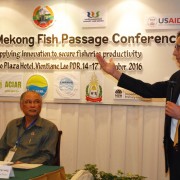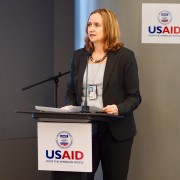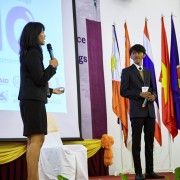
A native of Phnom Penh, Muyleang Kim spent her whole life in the city and was not familiar with agriculture. As a college student she chose to major in agricultural technology and management because she wanted to learn more about the sector and contribute to the development of Cambodia’s agriculture.
Kim is one of the youth leaders who participated in the Syngenta-USAID Ag Student Connections Program 2016 in Hanoi, Vietnam, with support from the USAID Feed the Future Asia Innovative Farmers project.

VIENTIANE, November 21, 2016 – Lao government officials and the National University of Laos agreed on an approach to develop national guidelines for monitoring fish passage at mainstream dams along the Mekong River. The decision to initiate the process came during an international conference in Vientiane last week aimed at protecting regional fisheries as river development projects expand.
In collaboration with the Association of Southeast Asian Nations (ASEAN), USAID, through the USAID Wildlife Asia activity, addresses wildlife trafficking by working to reduce demand of wildlife products and to improve regional action to end wildlife crime in Southeast Asia and China.

Today, over one billion people living in the Asia-Pacific region are able to access critical information and communication technologies that just a decade earlier were largely out of reach. In the next five years, more people in Asia will access the Internet for the first time than have done so in the previous 30 years. That’s an incredible statistic – a fact that will have a profound effect on the rate of economic, political and social change in the region.

SIEM REAP, October 31, 2016 – The United States and the Association of Southeast Asian Nations (ASEAN) awarded first place of the Young Southeast Asian Leaders Initiative (YSEALI) World of Food Innovation Challenge to a team of three Indonesian students from Gadjah Mada University. The team’s MINO Microbubble Generator technology increased oxygen in water and as a result, enlarged tilapia fish size by 40 percent, improved fish survival rate by nine percent, and ultimately increased tilapia fish farmers’ harvest.







Comment
Make a general inquiry or suggest an improvement.